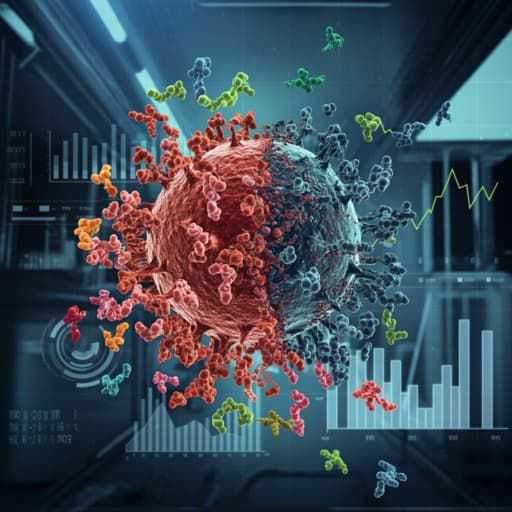
Biology
Immune Response in COVID-19 Recovered Vaccinated and Unvaccinated Individuals Related to Post-COVID-Syndrome
G. C, K. M, et al.
This study by Gerhards et al. explores the fascinating dynamics of antibodies in COVID-19 recovered individuals over 12 months, revealing intriguing insights into the impact of vaccination and the prevalence of Post-COVID Syndrome. Discover the significant trends in antibody levels and cognitive symptoms that arise a year after recovery.
~3 min • Beginner • English
Introduction
The study investigates long-term humoral immunity and post-COVID syndrome (PCS) in individuals recovered from COVID-19 during the first pandemic wave. Early antibody dynamics are known (seroconversion within 7–14 days, peak at ~30–35 days) and persistence up to 6 months has been reported. However, durability beyond 12 months and its clinical relevance for PCS remained unclear. The authors focused on RBD/S1 antibodies as correlates of neutralization and on N antibodies, assessing: (I) 12‑month anti-RBD/S1 and anti-N titers in unvaccinated convalescents and in those vaccinated after infection; (II) clinical parameters predicting declining anti-RBD/S1 after 1 year; and (III) prevalence and symptom profile of PCS at 12 months, including evaluation of cell-free DNA (cfDNA) at study entry as a potential early biomarker for PCS. They also examined whether vaccination after recovery influences an existing PCS.
Literature Review
Prior work established timelines for seroconversion (7–14 days) and peak antibody responses (~30–35 days), with several studies showing persistence up to 6 months. Anti-RBD/S1 levels correlate with neutralizing capacity, making them practical surrogates for humoral immunity. Vaccination strategies (e.g., STIKO recommendations) advise a single dose 6 months post-recovery, and some studies suggest vaccination prior to infection may reduce PCS risk. cfDNA has been linked to outcomes in sepsis, bacteremia, pneumonia and acute COVID-19 as a marker of tissue damage; thus it was explored as a potential early biomarker for PCS, particularly for respiratory sequelae. Evidence on HLA polymorphisms influencing acute COVID-19 severity exists, but their role in long-term antibody dynamics is uncertain.
Methodology
Design: Prospective longitudinal cohort (Immunitor Study) at University Medical Center Mannheim, Germany. Subjects ≥18 years with qRT-PCR–confirmed SARS-CoV-2 infection were enrolled ≥3 weeks after recovery (t0) and followed at t1 (2 weeks), t2 (4 weeks), t3 (3 months), t4 (6 months), and t5 (12 months).
Samples: At each visit, serum or lithium-heparin plasma was collected (7.5 mL), processed by centrifugation, aliquoted, and stored at −80°C. Serum used for t0–t3; plasma for t4–t5 (methods cross-validated).
Cohorts: V1 (verum, recovered), with two subgroups at t5: V1.1 (unvaccinated at 12 months) and V1.2 (vaccinated between 6 and 12 months; infected prior to vaccination). Trends in unvaccinated: trend 1 (anti-RBD/S1 decline >10% vs previous) and trend 2 (stable/increase, ≤10% decrease). Training set: t4 participants later vaccinated (V1.2) to avoid booster effects; Validation set: V1.1 at t5.
Serology: Anti-N Pan-Ig by qualitative ECLIA (Roche; COI ≥1.0 reactive). Anti-RBD/S1 total Ig by Elecsys Anti-SARS-CoV-2 S (Roche; ≥0.8 U/mL reactive). Analyses performed in accredited lab per manufacturer’s instructions and ISO 15189.
HLA typing: Conducted with the Institute of Transfusion Medicine and Immunology per standard protocol; common alleles examined for associations with declining RBD/S1.
cfDNA: At t0, EDTA plasma processed via double-centrifugation. cfDNA isolated (ViennaLab Plasma cfDNA Extraction Kit or Qiagen QIAamp Circulating Nucleic Acid Kit; 2 mL plasma), quantified with Qubit; reported as ng/mL.
Clinical data: Collected via REDCap at baseline and PCS symptoms re-assessed at 6 and 12 months.
Feature selection/prediction: Random forest with shadow variables to rank importance. Candidate features included demographics (age, sex, BMI, smoking), acute COVID-19 symptoms, treatment (ambulatory/inpatient/ICU), medical history (immune, autoimmune, vascular, pulmonary, gynecological, cancer, other), medications, blood group, PCS presence and symptom types. Models trained on t4 data; validated on V1.1 at t5. ROC/AUC used to evaluate models.
Statistics: R 4.1.1 and Excel 2019; p<0.05 significant. Graphs via GraphPad, R, PowerPoint. IRB approval (2020-556N) and informed consent obtained.
Key Findings
Cohort: 49 of 61 baseline subjects attended t5 (12 months). Median age 53.1 years (21–78), 65.3% female; mean BMI 25.8. Hospitalization during acute COVID-19: 12.5% (one-third ICU). Overall PCS prevalence: 46.9% at 6 months; 38.6% at 12 months.
Serology at t5: Anti-RBD/S1 detected in 48/49; anti-N in 46/49. One participant had qRT-PCR–confirmed reinfection between t4 and t5, with ~20-fold anti-N increase and ~138-fold anti-RBD/S1 increase.
Vaccination effects (V1.2, n=29): 22 BNT162b2, 2 mRNA-1273, 5 ChAdOx1 (one heterologous). Mean anti-RBD/S1 titer 34,967 ± 31,060 U/mL; mean 235 ± 382-fold increase over maximum post-convalescence titer (p<0.0001).
Unvaccinated 12-month dynamics (V1.1, n=18): Subdivided into V1.1_trend1 (decline >10%, n=7) and V1.1_trend2 (stable/increase, n=12; one with persistently negative titer excluded for some comparisons). Median anti-RBD/S1 comparable between groups (trend2: 218.8 U/mL; trend1: 203.0 U/mL; p=0.770). Mean percentage change vs prior value differed (trend2: 112.0% ± 32.0 vs trend1: 68.5% ± 9.9; p=0.001). Only one unvaccinated participant showed a >50% decrease from the prior value at 12 months.
Anti-N dynamics: Marked decline continued to 12 months; >85% had >10% decrease; 55% showed >50% decrease.
Clinical correlates of decline: No significant differences by gender (p=1.0), age (trend to younger age in declining group: 39.7 ± 11.9 vs 50.5 ± 12.1 years; p=0.101), baseline t4 RBD/S1 levels (p=0.222) or maximum RBD/S1 (p=0.176). BMI trended higher in declining group (29.9 ± 5.6; p=0.074). No effect of acute disease severity (p=0.370). Common HLA types (A*01, A*02, A*24, B*44, C*07, C*04, DR*13, DQ*03, DQ*05, DQ*06, DP*04) showed no association with decline (all p>0.1).
Prediction models: Random forest highlighted “other disease,” “vascular disease,” “other symptoms,” and BMI as important. Best ROC performance: “other disease” (AUC 0.74); “vascular disease + other diseases” (AUC 0.70); “other disease + other symptoms” (AUC 0.69). Validation in V1.1 (n=18): models “other disease” and “other disease + other symptoms” correctly predicted 4/7 declines with one false positive; “vascular disease + other diseases” and “BMI + other diseases” identified 3/7 with one false positive. Vascular disease showed a negative correlation with declining trend.
PCS dynamics: In V1.1, PCS reduced from 9/18 (t4) to 7/18 (t5). Across all subjects, PCS prevalence slightly decreased from 46.9% to 38.6% (ns). Cognitive impairments increased and were most frequent at 12 months: 8/49 at t5 vs 1/49 at t4 (p=0.006). Fatigue (5/49) and exhaustion (6/49) remained common. PCS presence did not associate with antibody trend in V1.1 (p=0.637). In V1.2, PCS 14 at t4 vs 11 at t5 (p=0.596), indicating no significant change after vaccination.
cfDNA: At t0, median cfDNA concentrations (recalculated to plasma): PCS 1.94 ng/mL [IQR 1.43–3.53] vs no-PCS 1.74 ng/mL [1.48–2.86]; no significant difference.
Discussion
The study shows durable anti-RBD/S1 seropositivity beyond 12 months among individuals infected before vaccination, with only a small subset showing notable declines, addressing the question of long-term humoral immunity after natural infection. Anti-N antibodies declined substantially over the year, consistent with literature and suggesting limited utility of N as a durable marker of past infection and potential relevance to reinfection risk in N-seronegative individuals. Vaccination after recovery produced a very strong booster response in anti-RBD/S1 titers, aligning with the concept of hybrid immunity. Attempts to identify clinical predictors of declining anti-RBD/S1 in unvaccinated convalescents revealed only weak tendencies (younger age, higher BMI), and HLA types and acute severity did not differentiate declining vs stable trajectories. Predictive models using accessible clinical variables had modest accuracy at best, limiting clinical applicability in their current form. Regarding PCS, overall prevalence decreased slightly by 12 months, but symptom profiles shifted toward cognitive complaints, which increased significantly, while sensory disturbances regressed in some cases but persisted in others. Vaccination after recovery did not significantly alter the course of preexisting PCS within the observed period. cfDNA at convalescent baseline did not discriminate individuals who later developed PCS, indicating it is not a suitable early biomarker for PCS, particularly for cognitive manifestations likely unrelated to cell death markers.
Conclusion
Unvaccinated convalescents generally maintained stable anti-RBD/S1 antibody levels up to 12 months, while anti-N antibodies declined markedly. Vaccination after recovery induced a pronounced booster effect in anti-RBD/S1 titers. No specific HLA types or clinical factors reliably predicted declines in anti-RBD/S1; predictive models based on routine clinical variables showed limited performance. PCS remained prevalent at 12 months (38.6%), with an increase in cognitive symptoms; vaccination after recovery did not significantly change existing PCS rates. Early cfDNA levels did not predict PCS development. Future studies should validate predictive models in larger, independent cohorts, integrate additional immunologic measures (neutralization, cellular immunity), and employ objective neurocognitive assessments to better characterize and predict long-term outcomes.
Limitations
Key limitations include a relatively small sample size for the unvaccinated long-term cohort due to widespread vaccination, limiting statistical power and generalizability. The prediction models, though based on clinical data, had modest discriminative ability and used non-specific composite variables (e.g., “other diseases”). Lack of objective cognitive testing may underestimate or misclassify cognitive PCS. Potential information bias from self-reported symptoms exists, although surveys preceded major media reporting on cognitive sequelae. Certain comorbidities (e.g., kidney, liver disease) were not analyzable due to absence in the training cohort. Single-center design may limit external validity.
Related Publications
Explore these studies to deepen your understanding of the subject.







